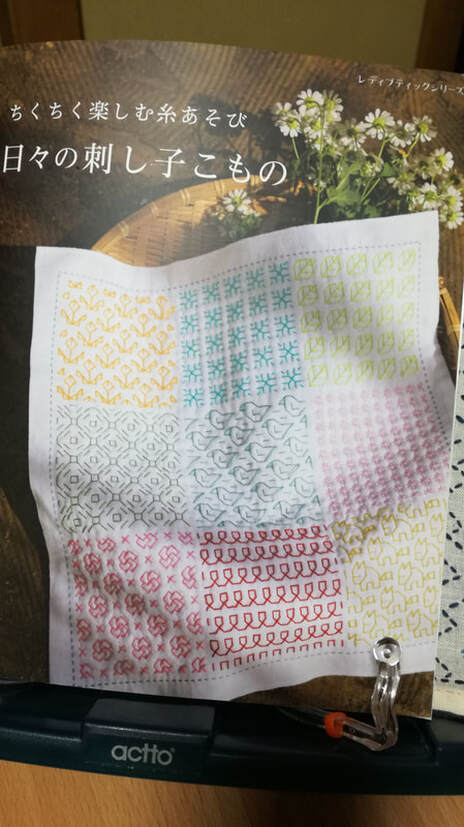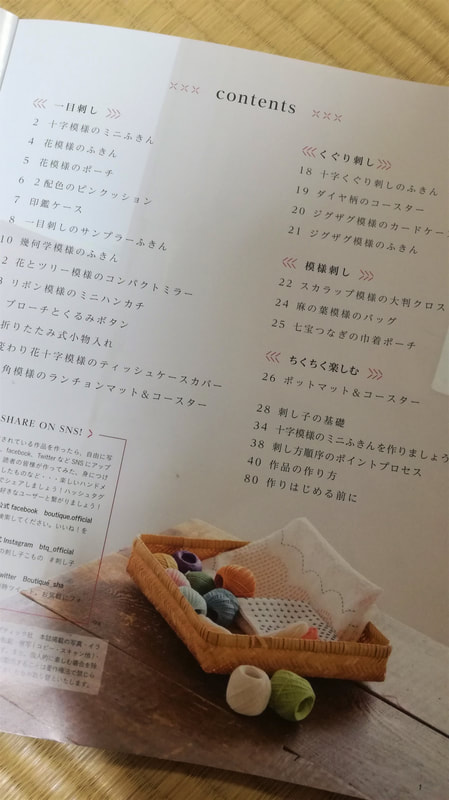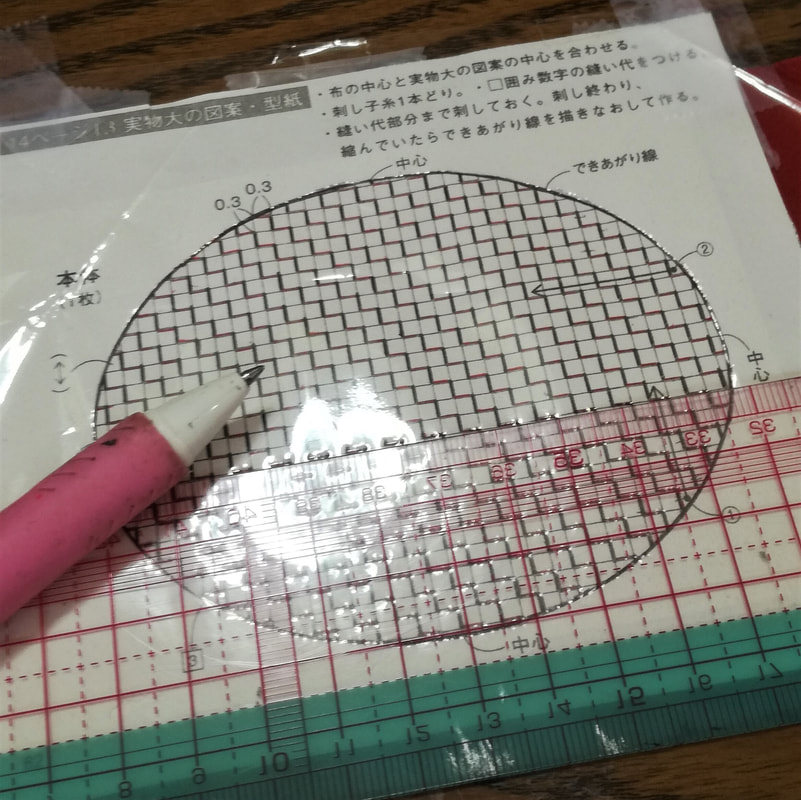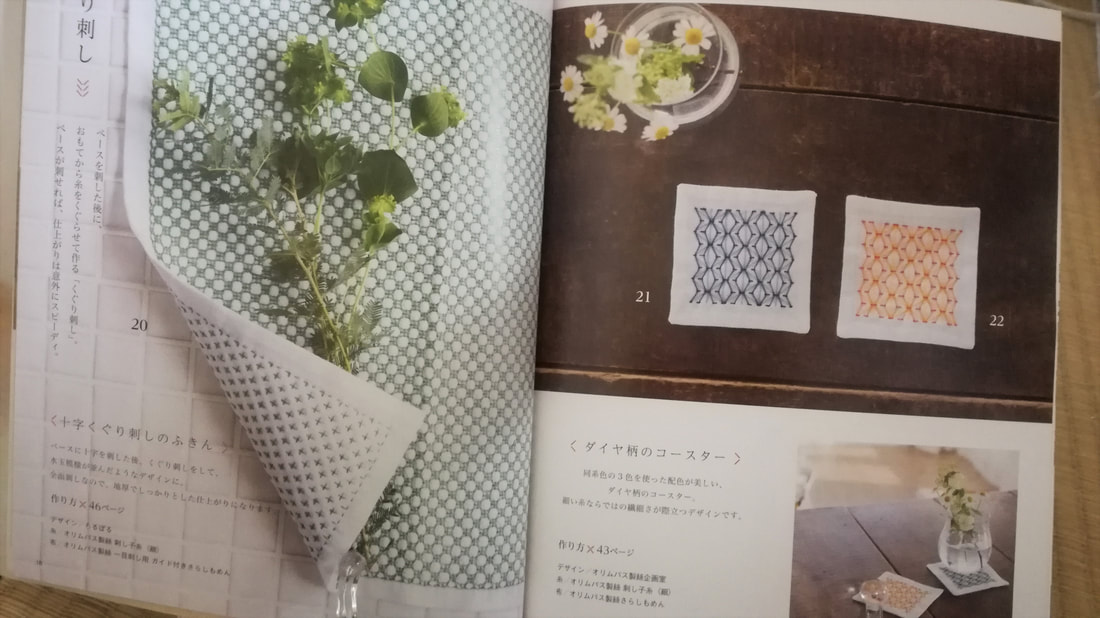|
This is the newest sashiko book to brighten up my desk. With its stylized and colourful patterns of leaves, flowers, pinwheels and other lovely things, the charming hanafukin on the cover represents perfectly what this book is all about: having fun with coloured thread. Chiku chiku tanoshimu ito asobi: Hibi no sashiko komono (Fun with thread and sewing: Everyday sashiko items for daily life), published by Boutique-sha this April, is a collection of hanafukin and daily items to make with beautiful coloured thread, according to the introduction. It is divided into four sections: Hitomezashi (one stitch sashiko), kugurizashi (threaded sashiko), moyozashi (pattern sashiko) and enjoying chiku chiku (more on that later). The hitomezashi section is the largest, with thirteen different items to make. There are the usual hanafukin, tablemats, coasters, as well as brooches, pincushions, a zip-up pouch, card cases and a fold-up accessory case. Patterns range from the simplest traditional cross stitch hanafukin in blue thread on white cloth, to the complex non-traditional creative patterns on the sampler hanafukin pictured on the cover. I happened to have a clover brooch set to hand, so I had a go at making the zig-zag patterned brooch pictured on page 14. The diagrams are to size, which makes it easy to copy. The kugurizashi section has four items: two different hanafukins, coasters and a card case. But pages 18 and 19 have to be my favourite in the whole book; the white hanafukin stitched with juji kuguri (threaded cross stitch) in green thread is just gorgeous – a fern-like lace! — while the two simple coasters on the opposite page, diamond pattern stitched in three colours, show off to advantage the possibilities of pattern and colour. This really speaks to me, as that creative potential is one of the things that drew me to sashiko in the first place. The moyozashi section has just three items: a large cloth in ‘scrap’ pattern (whatever that means – I’m not really sure); a lovely bag with a tobi asanoha (scattered hemp leaf) pattern; and, a cute round drawstring bag with the shippo tsunagi (linked seven treasures). Lastly, there is a section on enjoying chiku chiku. Chiku chiku means a prickly feeling or pricking motion. It’s often paired with the words for needle (hari) or work (shigoto) as a general term for needlework in Japanese, which of course includes sashiko. In a quick glance through my collection of sashiko books I found three with chiku chiku in the title, but none of those contained anything in the style of the items featured in the chiku chiku section of this book. The potholder and coasters are stitched with the straight-lined seemingly irregular stitches that typify chiku chiku. This is the first time I’ve seen a section devoted to chiku chiku in this type of sashiko book, which is perhaps an indication of its growing influence. It’s easy to understand its popularity when you see the amazingly artistic and inventive pieces in this blog post from Blue and White. As usual there is a section on the basics of sashiko; eight pages of photographs and diagrams, showing all the materials, basic instructions for transferring patterns, stitching processes, and guide to symbols used. Diagrams are clear, the patterns are to size, and some but not all are in colour. I was confused at first by the numbers in the list of contents, which I assumed matched the numbers for each item as pictured on the page because the fonts are the same. It took me a while to work out that the content numbers are actually page numbers. That was my only complaint. Here are four of the six sashiko artists who designed and created the pieces in this collection; Ayufish int, Sashiko Asaya, hako, and Chiisana teshigoto (click on their names to go their sites). You'll find some amazingly beautiful and inventive work on their pages. Have fun browsing!
2 Comments
Mary-Ella Arnold
4/28/2022 04:03:56 am
Have you translated it to English yet? I am interested in learning all the techniques. I have been doing Sashiko but see it leads to other interesting types of stitching. But I only speak English. I imagine the pictures would explain some of it but would like to read the text.
Reply
Leave a Reply. |
Watts SashikoI love sashiko. I love its simplicity and complexity, I love looking at it, doing it, reading about it, and talking about it. Archives
September 2022
Categories
All
Sign up for the newsletter:
|







 RSS Feed
RSS Feed



